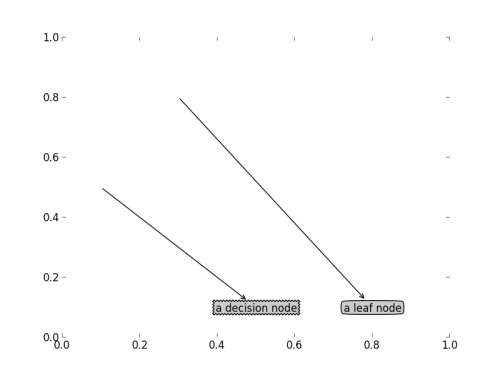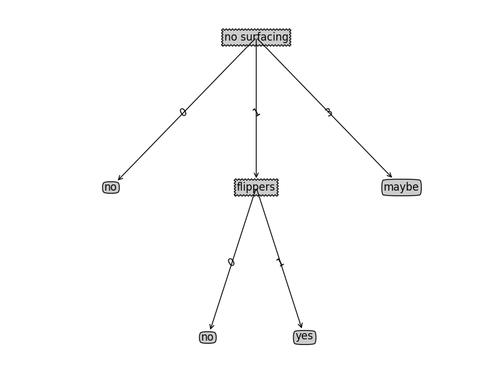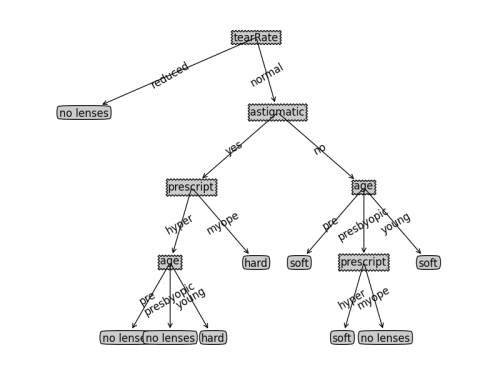机器学习实战精读--------决策树
Posted
tags:
篇首语:本文由小常识网(cha138.com)小编为大家整理,主要介绍了机器学习实战精读--------决策树相关的知识,希望对你有一定的参考价值。
感觉自己像个学走路的孩子,每一步都很吃力和认真!
机器根据数据集创建规则,就是机器学习。
决策树:从数据集合中提取一系列规则,适用于探索式的知识发现。
决策树本质:通过一系列规则对数据进行分类的过程。
决策树算法核心:构建精度高,数据规模小的决策树。
ID3算法:此算法目的在于减少树的深度,但是忽略了叶子数目的研究。
C4.5算法:对ID3进行改进,对于预测变量的缺失值处理、剪枝技术、派生规则等方面作了较大改进,既适合分类,又适合回归。
香农熵:变量的不确定性越大,熵也就越大,把它搞清楚所需要的信息量也就越大。
基尼不纯度:一个随机事件变成它的对立事件的概率。
#coding:utf-8
from math import log
import operator
#创建数据
def createDataSet():
dataSet = [[1, 1, ‘yes‘],
[1, 1, ‘yes‘],
[1, 0, ‘no‘],
[0, 1, ‘no‘],
[0, 1, ‘no‘]]
labels = [‘no surfacing‘,‘flippers‘]
#change to discrete values
return dataSet, labels
#计算给定数据集的香农熵
def calcShannonEnt(dataSet):
numEntries = len(dataSet)
#输出列表的的长度 值为:5
labelCounts = {}
for featVec in dataSet:
#对二维数组进行遍历
currentLabel = featVec[-1]
#把每个子列表的最后一个元素赋值给currentLabel
if currentLabel not in labelCounts.keys(): labelCounts[currentLabel] = 0
#如果currentLabel 不在字典中,把字典的值设置为0
# keys() 函数以列表返回一个字典所有的键。
labelCounts[currentLabel] += 1
#这一步是统计出现的次数,每次匹配到的话,把对应key的值加1
#操作完以后labelCounts字典记录的是yes出现2次 no出现3次
shannonEnt = 0.0
for key in labelCounts:
prob = float(labelCounts[key])/numEntries
#prob是字典labelCounts每个key的比率
shannonEnt -= prob * log(prob,2)
#log(x, 2) 表示以2为底的对数。
return shannonEnt
#熵数字越大,说明混合的数据越多
#按照给定特征划分数据集
def splitDataSet(dataSet, axis, value):
#dataSet:待划分的数据集;axis:划分数据集的特征;value:需要返回的特征的值
retDataSet = []
for featVec in dataSet:
if featVec[axis] == value:
#如果featVec列表的特征值跟valve值一样
reducedFeatVec = featVec[:axis]
#输出列表featVec开头到特征值的列表切片
reducedFeatVec.extend(featVec[axis+1:])
retDataSet.append(reducedFeatVec)
return retDataSet
#选择最好的数据集划分方式
def chooseBestFeatureToSplit(dataSet):
numFeatures = len(dataSet[0]) - 1 #the last column is used for the labels
baseEntropy = calcShannonEnt(dataSet)
bestInfoGain = 0.0; bestFeature = -1
for i in range(numFeatures): #iterate over all the features
featList = [example[i] for example in dataSet]#create a list of all the examples of this feature
uniqueVals = set(featList) #get a set of unique values
newEntropy = 0.0
for value in uniqueVals:
subDataSet = splitDataSet(dataSet, i, value)
prob = len(subDataSet)/float(len(dataSet))
newEntropy += prob * calcShannonEnt(subDataSet)
infoGain = baseEntropy - newEntropy #calculate the info gain; ie reduction in entropy
if (infoGain > bestInfoGain): #compare this to the best gain so far
bestInfoGain = infoGain #if better than current best, set to best
bestFeature = i
return bestFeature #returns an integer
def majorityCnt(classList):
classCount={}
for vote in classList:
if vote not in classCount.keys(): classCount[vote] = 0
classCount[vote] += 1
sortedClassCount = sorted(classCount.iteritems(), key=operator.itemgetter(1), reverse=True)
return sortedClassCount[0][0]
def createTree(dataSet,labels):
classList = [example[-1] for example in dataSet]
if classList.count(classList[0]) == len(classList):
return classList[0]#stop splitting when all of the classes are equal
if len(dataSet[0]) == 1: #stop splitting when there are no more features in dataSet
return majorityCnt(classList)
bestFeat = chooseBestFeatureToSplit(dataSet)
bestFeatLabel = labels[bestFeat]
myTree = {bestFeatLabel:{}}
del(labels[bestFeat])
featValues = [example[bestFeat] for example in dataSet]
uniqueVals = set(featValues)
for value in uniqueVals:
subLabels = labels[:] #copy all of labels, so trees don‘t mess up existing labels
myTree[bestFeatLabel][value] = createTree(splitDataSet(dataSet, bestFeat, value),subLabels)
return myTree
#使用决策树的分类函数
def classify(inputTree,featLabels,testVec):
firstStr = inputTree.keys()[0]
secondDict = inputTree[firstStr]
featIndex = featLabels.index(firstStr)
key = testVec[featIndex]
valueOfFeat = secondDict[key]
if isinstance(valueOfFeat, dict):
classLabel = classify(valueOfFeat, featLabels, testVec)
else: classLabel = valueOfFeat
return classLabel
#使用pickle模块存储决策树
def storeTree(inputTree,filename):
import pickle
fw = open(filename,‘w‘)
pickle.dump(inputTree,fw)
fw.close()
def grabTree(filename):
import pickle
fr = open(filename)
return pickle.load(fr)#coding:utf-8
import matplotlib as mpl
mpl.use(‘Agg‘)
import matplotlib.pyplot as plt
decisionNode = dict(boxstyle="sawtooth", fc="0.8")
leafNode = dict(boxstyle="round4", fc="0.8")
arrow_args = dict(arrowstyle="<-")
def getNumLeafs(myTree):
numLeafs = 0
firstStr = myTree.keys()[0]
secondDict = myTree[firstStr]
for key in secondDict.keys():
if type(secondDict[key]).__name__==‘dict‘:#test to see if the nodes are dictonaires, if not they are leaf nodes
numLeafs += getNumLeafs(secondDict[key])
else: numLeafs +=1
return numLeafs
def getTreeDepth(myTree):
maxDepth = 0
firstStr = myTree.keys()[0]
secondDict = myTree[firstStr]
for key in secondDict.keys():
if type(secondDict[key]).__name__==‘dict‘:#test to see if the nodes are dictonaires, if not they are leaf nodes
thisDepth = 1 + getTreeDepth(secondDict[key])
else: thisDepth = 1
if thisDepth > maxDepth: maxDepth = thisDepth
return maxDepth
def plotNode(nodeTxt, centerPt, parentPt, nodeType):
createPlot.ax1.annotate(nodeTxt, xy=parentPt, xycoords=‘axes fraction‘,
xytext=centerPt, textcoords=‘axes fraction‘,
va="center", ha="center", bbox=nodeType, arrowprops=arrow_args )
def plotMidText(cntrPt, parentPt, txtString):
xMid = (parentPt[0]-cntrPt[0])/2.0 + cntrPt[0]
yMid = (parentPt[1]-cntrPt[1])/2.0 + cntrPt[1]
createPlot.ax1.text(xMid, yMid, txtString, va="center", ha="center", rotation=30)
def plotTree(myTree, parentPt, nodeTxt):#if the first key tells you what feat was split on
numLeafs = getNumLeafs(myTree) #this determines the x width of this tree
depth = getTreeDepth(myTree)
firstStr = myTree.keys()[0] #the text label for this node should be this
cntrPt = (plotTree.xOff + (1.0 + float(numLeafs))/2.0/plotTree.totalW, plotTree.yOff)
plotMidText(cntrPt, parentPt, nodeTxt)
plotNode(firstStr, cntrPt, parentPt, decisionNode)
secondDict = myTree[firstStr]
plotTree.yOff = plotTree.yOff - 1.0/plotTree.totalD
for key in secondDict.keys():
if type(secondDict[key]).__name__==‘dict‘:#test to see if the nodes are dictonaires, if not they are leaf nodes
plotTree(secondDict[key],cntrPt,str(key)) #recursion
else: #it‘s a leaf node print the leaf node
plotTree.xOff = plotTree.xOff + 1.0/plotTree.totalW
plotNode(secondDict[key], (plotTree.xOff, plotTree.yOff), cntrPt, leafNode)
plotMidText((plotTree.xOff, plotTree.yOff), cntrPt, str(key))
plotTree.yOff = plotTree.yOff + 1.0/plotTree.totalD
#if you do get a dictonary you know it‘s a tree, and the first element will be another dict
def createPlot(inTree):
fig = plt.figure(1, facecolor=‘white‘)
fig.clf()
axprops = dict(xticks=[], yticks=[])
createPlot.ax1 = plt.subplot(111, frameon=False, **axprops) #no ticks
#createPlot.ax1 = plt.subplot(111, frameon=False) #ticks for demo puropses
plotTree.totalW = float(getNumLeafs(inTree))
plotTree.totalD = float(getTreeDepth(inTree))
plotTree.xOff = -0.5/plotTree.totalW; plotTree.yOff = 1.0;
plotTree(inTree, (0.5,1.0), ‘‘)
plt.savefig(‘trees.png‘)
‘‘‘
def createPlot():
fig = plt.figure(1, facecolor=‘white‘)
#创建第一张图,设置背景色是白色
fig.clf()
createPlot.ax1 = plt.subplot(111, frameon=False) #ticks for demo puropses
plotNode(‘a decision node‘, (0.5, 0.1), (0.1, 0.5), decisionNode)
plotNode(‘a leaf node‘, (0.8, 0.1), (0.3, 0.8), leafNode)
plt.savefig(‘trees.png‘)
‘‘‘
def retrieveTree(i):
listOfTrees =[{‘no surfacing‘: {0: ‘no‘, 1: {‘flippers‘: {0: ‘no‘, 1: ‘yes‘}}}},
{‘no surfacing‘: {0: ‘no‘, 1: {‘flippers‘: {0: {‘head‘: {0: ‘no‘, 1: ‘yes‘}}, 1: ‘no‘}}}}
]
return listOfTrees[i]
小结:
一、一棵最优决策树主要应解决以下三个问题:
① 生成最少数目的叶子节点
② 生成每个叶子节点的深度最小
③ 生成的决策树叶子节点最少且每个叶子节点深度最小
二、如果叶子节点只能增加少许信息,则可以删除该节点,将它并入到其它节点中去。
三、ID3算法无法直接处理数值型数据。
四、采用文本方式很难展示决策树,所以要用Matplotlib注解绘制树型图。
本文出自 “付炜超” 博客,谢绝转载!
以上是关于机器学习实战精读--------决策树的主要内容,如果未能解决你的问题,请参考以下文章


